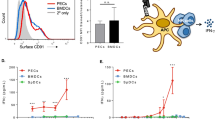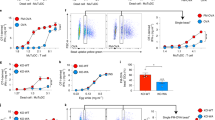Abstract
Antigen presenting cells (APCs) can take up exogenous antigenic peptides chaperoned by heat shock protein gp96 and re-present them through the endogenous pathway on their major histocompatibility class I molecules. The high efficiency of this process has been attributed previously to a receptor for gp96 on APCs. The CD91 molecule (also called α2-macroglobulin receptor or the low density lipoprotein–related protein) is shown here to be a cell surface receptor for the heat shock protein gp96. CD91 binds gp96 directly, rather than through another ligand for CD91. The previously known CD91 ligand, α2-macroglobulin, inhibits re-presentation of gp96-chaperoned antigenic peptides by macrophages, as do antibodies to CD91. As gp96 is exclusively intracellular and is released as a result of necrotic but not apoptotic cell death, we propose that CD91 acts as a sensor for necrotic cell death.
This is a preview of subscription content, access via your institution
Access options
Subscribe to this journal
Receive 12 print issues and online access
$209.00 per year
only $17.42 per issue
Buy this article
- Purchase on Springer Link
- Instant access to full article PDF
Prices may be subject to local taxes which are calculated during checkout





Similar content being viewed by others
References
Bevan, M.J. Antigen presentation to cytotoxic T lymphocytes in vivo. J. Exp. Med. 182, 639–641 (1995).
Suto, R. & Srivastava, P.K. A mechanism for the specific immunogenicity of heat shock protein - chaperoned peptides. Science 269, 1585–1588 ( 1995).
Srivastava, P.K., Ménoret, A., Basu, S., Binder, R.J. & McQuade, K.L. Heat Shock proteins come of age: primitive functions acquire new roles in an adaptive world. Immunity 8, 657–665 ( 1998).
Ishii, T. et al. Isolation of MHC class I – restricted tumor antigen peptide and its precursors associated with heat shock proteins hsp70, hsp90, and gp96 . J. Immunol. 162, 1303– 1309 (1999).
Nieland, J.D. et al. Chimeric papillomavirus virus-like particles elicit antitumor immunity against the E7 oncoprotein in an HPV16 tumor model. Proc. Natl Acad. Sci. USA 95, 1800–1805 (1998).
Arnold, D., Faath, S., Rammensee, H. & Schild, H. Cross-priming of minor histocompatibility antigen-specific cytotoxic T cells upon immunization with the heat shock protein gp96. J. Exp. Med. 182, 885–889 (1995).
Breloer, M., Marti, T., Fleischer, B. & von Bonin, A. Isolation of processed, H-2Kb-binding ovalbumin-derived peptides associated with the stress proteins HSP70 and gp96. Eur. J. Immunol. 28, 1016–1021 (1998).
Ménoret, A. & Srivastava, P.K. Association of peptides with the heat shock protein gp96 occurs in vivo and is not a post-cell lysis event. Biochem. Biophys. Res. Commun. 262, 813–818 (1999).
Tamura, Y., Peng, P., Liu, K., Daou, M. & Srivastava, P.K. Immunotherapy of tumors with autologous tumor-derived heat shock protein preparations. Science 278, 117–120 (1997).
Blachere, N.E. et al. Heat shock protein-peptide complexes, reconstituted in vitro, elicit peptide-specific cytotoxic T lymphocyte response and tumor immunity. J. Exp. Med. 186, 1183– 1406 (1997).
Udono, H., Levey, D.L. & Srivastava, P.K. Cellular requirements for tumor - specific immunity elicited by heat shock proteins: Tumor rejection antigen gp96 primes CD8+ T cells in vivo. Proc. Natl Acad. Sci. USA 91, 3077–3081 (1994).
Srivastava, P.K., Udono, H., Blachere, N.E. & Li, Z. Heat shock proteins transfer peptides during antigen processing and CTL priming . Immunogenetics 39, 93– 98 (1994).
Binder, R.J., Ménoret, A. & Srivastava, P.K. Receptor-dependent and receptor-independent re-presentation of heat-shock protein-chaperoned peptides. Cell Stress Chap. 3, 2 (1998).
Arnold-Schild, D. et al. Cutting edge: receptor-mediated endocytosis of heat shock proteins by professional antigen-presenting cells. J. Immunol. 162, 3757–3760 ( 1999).
Wassenberg, J.J., Dezfulian, C. & Nicchitta, C.V. Receptor mediated and fluid phase pathways for internalization of the ER Hsp90 chaperone GRP94 in murine macrophages. J. Cell Sci. 112, 2167–2175 ( 1999).
Singh-Jasuja, H. et al. Cross-Presentation of Glycoprotein 96-associated Antigens on Major Histocompatibility Complex Class I Molecules Requires Receptor-mediated Endocytosis. J. Exp. Med. 191, 1965– 1974 (2000).
Binder, R.J., Harris, M., Menoret, A. & Srivastava, P.K. Saturation, competition and specificity in interaction of heat shock proteins gp96, hsp90 and hsp70 with CD11b+ cells. J. Immunol. (2000) (in the press).
Binder, R.J., Basu, S, Anderson, K.M. & Srivastava, P.K. RAW264.7 but not RAW309Cr.1 cells can re-present HSP-chaperoned peptides. J. Immunol. (2000) (submitted).
Huang, A.Y. et al. The immunodominant major histocompatibility complex class I-restricted antigen of a murine colon tumor derives from an endogenous retroviral gene product. Proc. Natl Acad. Sci. USA 93, 9730–9735 (1996).
Strickland, D.K. et al. Sequence identity between the α2-macroglobulin receptor and low density lipoprotein receptor-related protein suggests that this molecule is a multifunctional receptor. J. Biol. Chem. 265, 17401–17404 (1990).
Kristensen, T. et al. Evidence that the newly cloned low-density-lipoprotein receptor related protein (LRP) is the α2-macroglobulin receptor. FEBS Lett. 276, 151–155 (1990).
Van Leuven, F. et al. Molecular cloning and sequencing of the murine α 2-macroglobulin receptor cDNA. Biochim. Biophys. Acta 1173, 71–74 (1993).
O'Connor-McCourt, M.D. & Wakefield, L.M. Latent transforming growth factor β in serum: a specific complex with α2-macroglobulin . J. Biol. Chem. 262, 14090– 14099 (1987).
Huang, J.S., Huang, S.S. & Deuel, T.F. Specific covalent binding of platelet-derived growth factor to human plasma α2-macroglobulin. Proc. Natl Acad. Sci. USA 81, 342–346 (1984).
Dennis, P.A., Saksela, O., Harpel, P. & Rifkin, D.B. α 2-macroglobulin is a binding protein for basic fibroblast growth factor . J. Biol. Chem. 264, 7210– 7216 (1989).
Orth, K., Madison, E.L., Gething, M.J., Sambrook, J.F. & Herz, J. Complexes of tissue-type plasminogen activator and its serpin inhibitor plasminogen-activator inhibitor type 1 are internalized by means of the low density lipoprotein receptor-related protein/α2-macroglobulin receptor. Proc. Natl Acad. Sci. USA 89, 7422–7426 (1992).
Nykjaer, A. et al. Purified α2-macroglobulin receptor/LDL receptor-related protein binds urokinase.plasminogen activator inhibitor type-1 complex. Evidence that the α2-macroglobulin receptor mediates cellular degradation of urokinase receptor-bound complexes. J. Biol. Chem. 267, 14543–14546 (1992).
Jensen, P.E.H. & Pizzo, S.V. Comparison of α 2-macroglobulin receptors from human, baboon, rat, and mouse liver. Biochem. Arch. 5, 171–176 (1989).
Maki, R.G., Eddy, R.L., Byers, M., Shows, T.B. & Srivastava, P.K. Mapping of the genes for human endoplasmic reticular HSP gp96/grp94. Somat. Cell Mol. Gen. 19, 73–81 (1993).
Hilliker, C., Van Leuven, F. & Van den Berghe, H. Assignment of the gene coding for the α2 -macroglobulin receptor to mouse chromosome 15 and to human chromosome 12q13-q14 by isotopic and non-isotopic in situ hybridization. Genomics 13, 472–474 ( 1992).
Basu, S, Binder, R.J., Suto, R., Anderson, K.M. & Srivastava, P.K. Necrotic but not apoptotic cell death releases heat shock proteins, which deliver a maturation signal to dendritic cells and activate the NF-κB pathway. Int. Immunol. ( 2000) (submitted).
Savill, J., Hogg, N., Ren, Y. & Haslett, C. Thrombospondin cooperates with CD36 and the vitronectin receptor in macrophage recognition of neutrophils undergoing apoptosis. J. Clin. Invest. 90, 1513–1522 (1992).
Fadok, V.A. et al. A receptor for phosphatidylserine-specific clearance of apoptotic cells. Nature 405, 85–90 (2000).
Matzinger, P. An innate sense of danger. Semin Immunol. 10, 399–415 (1998).
Srivastava, P.K., DeLeo, A.B. & Old, L.J. Tumor rejection antigens of chemically induced sarcomas of inbred mice. Proc. Natl Acad. Sci. USA 83, 3407–3411 (1986).
Acknowledgements
Supported by NIH grants CA64394 and CA84479, and a research agreement with Antigenics Inc., in which P.K.S. has a significant financial interest. We thank S. Basu for sharing unpublished observations and for refining and making available the re-presentation assay, T. Matsutake, K. Anderson and R. Berlin for discussion and evaluation of experiments, and D. Ritsick for assistance with the cross-linking studies.
Author information
Authors and Affiliations
Corresponding author
Rights and permissions
About this article
Cite this article
Binder, R., Han, D. & Srivastava, P. CD91: a receptor for heat shock protein gp96. Nat Immunol 1, 151–155 (2000). https://doi.org/10.1038/77835
Received:
Accepted:
Issue Date:
DOI: https://doi.org/10.1038/77835
This article is cited by
-
Activation of immune signals during organ transplantation
Signal Transduction and Targeted Therapy (2023)
-
TMEM16A as a potential treatment target for head and neck cancer
Journal of Experimental & Clinical Cancer Research (2022)
-
Tunable heat shock protein-mediated NK cell responses are orchestrated by STAT1 in Antigen Presenting Cells
Scientific Reports (2021)
-
A new antisarcoma strategy: multisubtype heat shock protein/peptide immunotherapy combined with PD-L1 immunological checkpoint inhibitors
Clinical and Translational Oncology (2021)
-
The active contribution of OPCs to neuroinflammation is mediated by LRP1
Acta Neuropathologica (2020)



